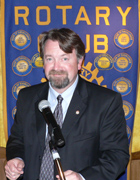Banning House Museum, by Michael Sanborn

Michael Sanborn is the Director of the Banning House Museum, and the co-author of a 2008 book, Images of America: Wilmington, about the local history including the Banning Museum and the Drum Barracks. He has supervised a recently completed $2.5 million multiyear project to expand the Museum in the unused basement, to document the history of transportation in the Los Angeles Harbor area.
Phineas Banning was the founder of Wilmington, which he named after his hometown of Wilmington, Delaware. He had been hired to transport cargo to California in 1851, and on his arrival saw a business opportunity in the potential port, at that time only a mud flat many miles from the isolated town of Los Angeles. He established a business of stagecoach and freight wagons between the port and the town, and extended cargo connections eastward to San Bernardino.
As a California state senator, he was instrumental in bringing the first railroad to Los Angeles to connect with his system, ensuring the growth of Los Angeles into a great city. He arranged harbor dredging to build a deepwater port for ships to connect with his freight wagons. He built a 220 acre ranch with a 17,000 ft² home and barn, which he offered to Union troops during the Civil War. His family lived there for many years until 1929 when it became the current Museum on the remaining 19½ acres.
Mr Sanborn discussed the fundraising difficulties during government budget limitations, and showed many photos of the Museum expansion project. The unused basement floor is actually the newest part of the house, built about 1900 because the original house was rotting underneath from the high water table. A ballroom was constructed there, but in later years it was closed off. The new construction required trenching up to 9 feet deep to about 3 feet below the foundation to build a concrete water barrier around the house, and an access ramp was constructed. A French drain was installed to gravity-feed ground water into a well.
The original mortar was dug out from between the basement wall bricks, analyzed and duplicated to provide the same structural properties. Round windows dating from 1864 were exposed after outside bricks were removed, and some of the glass panels were reproduced to match original materials. No architectural plans were available, so the mahogany front deck and steps were reconstructed from old photos, and the wood was hand cut on site from clear-grain mahogany. The original roads in the park have been dug out and reconstructed. The Rose Garden has been replanted with original varieties.
The new basement exhibition (Improbable Gateway: The Los Angeles Transportation Legacy) is now finished, illustrating the evolution of transportation from harbor dredging and roads to rails and the transcontinental railroad. The display panels are arranged in chronological order for smooth flow of visitors. Each panel shows photos and large print describing the major ideas, with more details in smaller print.
The project is now completed except for refurbishing the barn with its display of vehicles. 2014 is the 150th anniversary of the site, and a major celebration is planned next year, especially on August 18, Phineas Banning's birthday. Mr Sanborn invites us to experience this exciting new major permanent exhibition at the Banning Museum (http://www.banningmuseum.org/).